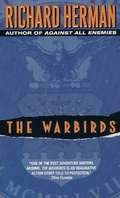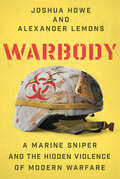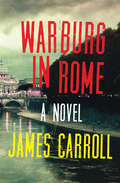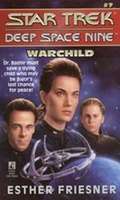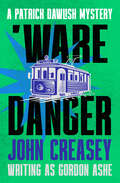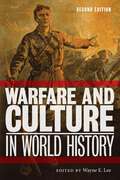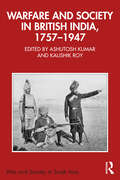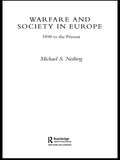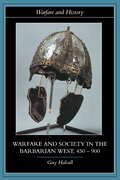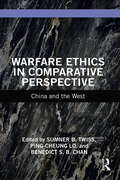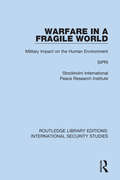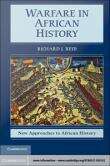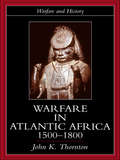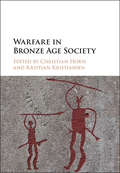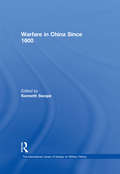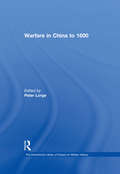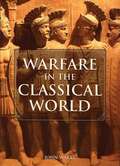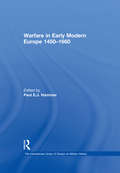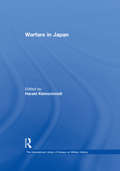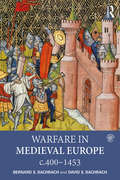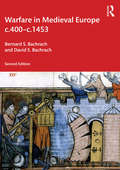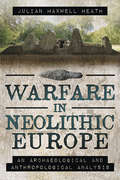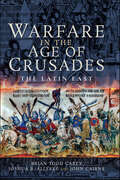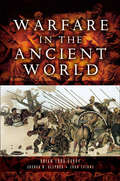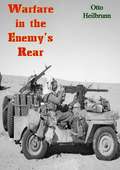- Table View
- List View
Warbirds
by Richard HermanColonel Anthony "Muddy" Waters has a mission: to mold a company of poorly trained rogues and misfits into heroes. His assignment is one that no other officer in the United States Air Force would touch. But Waters has a fabled stubbornness and dedication unparalleled in the armed services ... and the will to make the impossible possible. The Warbirds is the breakthrough novel that captures the saga of the F-4 Phantom and the men who made it a legend: like "Muddy" Waters, who must transform the men and women under his command -- Including a superbly talented pilot but loose cannon named Jack Locke-into a fighting force to be reckoned with. Because their country could ask them at any time to fly their F-4s into the eye of the firestorm, to face an overwhelming enemy and brave the flames of hell itself without question and with no support. Tomorrow that call will come. And there will be no turning backwhen the heavens explode.
Warbody: A Marine Sniper and the Hidden Violence of Modern Warfare
by Joshua Howe Alexander LemonsA friendship between an environmental historian and a chronically ill US Marine yields a powerful exploration into the toxic effects of war on the human body. Alexander Lemons is a Marine Corps scout sniper who, after serving multiple tours during the Iraq War, returned home seriously and mysteriously ill. Joshua Howe is an environmental historian who met Lemons as a student in one of his classes. Together they have crafted a vital book that challenges us to think beyond warfare’s acute violence of bullets and bombs to the “slow violence” of toxic exposure and lasting trauma. In alternating chapters, Lemons vividly describes his time in Fallujah and elsewhere during the worst of the Iraq War, his descent into a decade-long battle with mysterious and severe sickness, and his return to health; Howe explains, with clarity and scientific insight, the many toxicities to which Lemons was exposed and their potential consequences. Together they cover the whirlwind of toxic exposures military personnel face from the things they touch and breathe in all the time, including lead from bullets, jet fuel, fire retardants, pesticides, mercury, dust, and the cocktail of toxicants emitted by the open-air “burn pits” used in military settings to burn waste products like paint, human waste, metal cans, oil, and plastics. They also consider PTSD and traumatic brain injury, which are endemic among the military and cause and exacerbate all kinds of physical and mental health problems. Finally, they explore how both mainstream and alternative medicine struggle to understand, accommodate, and address the vast array of health problems among military veterans. Warbody challenges us to rethink the violence we associate with war and the way we help veterans recover. It is a powerful book with an urgent message for the nearly twenty million Americans who are active military or veterans, as well as for their families, their loved ones, and all of us who depend on their service.
Warburg in Rome: A Novel
by James CarrollIn post-WWII Italy, an American uncovers a Vatican scandal in a &“thriller with deeply serious historical undertones&” by a National Book Award winner (Alan Cheuse, NPR, All Things Considered). David Warburg, newly minted director of the US War Refugee Board, arrives in Rome at war&’s end, determined to bring aid to the destitute European Jews streaming into the city. Marguerite d&’Erasmo, a French-Italian Red Cross worker with a shadowed past, is initially Warburg&’s guide—while a charismatic young American Catholic priest, Monsignor Kevin Deane, seems equally committed to aiding Italian Jews. But the city is a labyrinth of desperate fugitives: runaway Nazis, Jewish resisters, and criminal Church figures. Marguerite, caught between justice and revenge, is forced to play a double game. At the center of the maze, Warburg discovers one of history&’s great scandals: the Vatican ratline, a clandestine escape route maintained by Church officials and providing scores of Nazi war criminals with secret passage to South America. Turning to American intelligence officials, he learns that the dark secret is not as secret as he thought—and that even those he trusts may betray him—in this &“complex and compelling novel of the Vatican and morality during World War II&” (Library Journal). Warburg in Rome has &“the breathtaking pace of a thriller and the gravitas of a genuine moral center—as if John LeCarré and Graham Greene collaborated&” (Mary Gordon). &“A high-stakes battle between good and evil [and] a plot full of twists and turns.&” —The Boston Globe &“A suspenseful historical drama set in Rome at the end of WWII and centering on Vatican complicity in the flight of Nazi fugitives to Argentina.&” —Publishers Weekly &“Recommend this utterly engaging thriller to fans of Joseph Kanon&’s The Good German and James R. Benn&’s Death&’s Door.&” —Booklist, starred review
Warchild (Star Trek #7)
by Esther FriesnerA message left behind by the Kai Opaka gives Commander Benjamin Sisko a fateful mission: find a young Bajoran girl destined to be a great healer who could bring together the warring factions of Bajor. While Lt. Dax tries to find the healer, Dr. Bashir goes planetside to treat a rare disease that is killing the children in Bajor's resettlement camps. Surrounded by thousands of dying children, Bashir goes A.W.O.L. from Deep Space Nine TM, vowing not to return until the plague has been stopped. But by the time Dax finds the girl from the Kai's prophecy the child has fallen victim to the plague. Now, with the fate of the entire planet at stake, Commander Sisko must find Dr. Bashir in time to save the child who may be Bajor's last chance for peace.
'Ware Danger (The Patrick Dawlish Mysteries)
by Gordon AsheBritish sleuth Patrick Dawlish is about to discover that during World War II, there&’s as much intrigue on the home front as on the front lines. The big, broken-nosed Patrick Dawlish has a history of matching wits against those who have outwitted the police. It&’s practically become his chosen vocation when he&’s not serving in Her Majesty&’s armed forces. Dawlish&’s requests to serve overseas have been rejected since he&’s far too valuable in England. This is how he finds himself on a train to London with friends Ted Beresford and Timothy Jeremy—three junior officers with the same mysterious orders to meet in the same mysterious room. Someone is attempting to sabotage negotiations between Ireland and England—and delaying much-needed wartime supplies. Within a day of reaching London, Dawlish and his men are faced with fires, explosions, and a shocking political assassination. And now, at least two countries will learn that it&’s never smart to have Dawlish in the mix when he begins to take matters personally . . .
Warfare and Culture in World History, Second Edition (Warfare And Culture Ser. #9)
by Wayne E. LeeAn expanded edition of the leading text on military history and the role of culture on the battlefieldIdeas matter in warfare. Guns may kill, but ideas determine when, where, and how they are used. Traditionally, military historians attempted to explain the ideas behind warfare in strictly rational terms, but over the past few decades, a stronger focus has been placed on how societies conceptualize war, weapons, violence, and military service, to determine how culture informs the battlefield. Warfare and Culture in World History, Second Edition, is a collection of some of the most compelling recent efforts to analyze warfare through a cultural lens. These curated essays draw on, and aggressively expand, traditional scholarship on war and society through sophisticated cultural analysis. Chapters range from an organizational analysis of American Civil War field armies, to an exploration of military culture in late Republican Rome, to debates within Ming Chinese officialdom over extermination versus pacification.In addition to a revised and expanded introduction, the second edition of Warfare and Culture in World History now adds new chapters on the role of herding in shaping Mongol strategies, Spanish military culture and its effects on the conquest of the New World, and the blending of German and East African military cultures among the Africans who served in the German colonial army. This volume provides a full range of case studies of how culture, whether societal, strategic, organizational, or military, could shape not only military institutions but also actual battlefield choices.
Warfare and Society in British India, 1757–1947 (War and Society in South Asia)
by Ashutosh Kumar Kaushik RoyThis book explores the intricate and intimate relationship between military organization, imperial policy, and society in colonial South Asia. The chapters in the volume focus on technology, logistics, and state building. The present volume highlights the salient features of expansion and consolidation of imperial control over the subcontinent, and ultimate demise of the Raj. Further, it turns the spotlight on to subaltern challenges to imperialism as well as the role of non-combatants in warfare. The volume: • Deals with both conventional and guerrilla conflicts and focuses on the frontiers (both North-West and North-East, including Burma); • Looks at the army as an institution rather than present a chronological account of military operations, which highlights the complex and tortuous relationship between combat institution, colonial state, and Indian society; • Integrates top-down approaches in military and strategic studies with the bottom-up perspectives and discusses on how the conduct of war (organisation and technology) is related to the economic, societal, and cultural impact of war. A rich account of the British ‘Army in India’, this book will be essential reading for scholars and researchers of South Asian history, military history, political history, colonialism, and the British Empire.
Warfare and Society in Europe: 1898 to the Present (Warfare And History Ser.)
by Michael S. NeibergWarfare and Society in Europe, 1898 to the Present examines warfare in Europe from the Fashoda conflict in modern-day Sudan to the recent war in Iraq. The twentieth century was by far the world's most destructive century with two global wars marking the first half of the century and the constant fear of nuclear annihilation haunting the second half
Warfare and Society in the Barbarian West 450-900 (Warfare and History)
by Guy HalsallGuy Halsall relates warfare to many aspects of medieval life, economy, society and politics.This book recovers its distinctiveness, looking at warfare in a rounded context in the British Isles and Western Europe between the end of the Roman Empire and the break-up of the Carolingian Empire. Examining the raising and organization of early medieval armies and looks at the conduct of campaigns, the survey also includes a study of the equipment of warriors and the horrific experience of battle as well as an analysis of medieval fortifications and siege warfare. Warfare and Society in the Barbarian West uses historical and archaeological evidence in a rigorous and sophisticated fashion. It stresses regional variations but also places Anglo-Saxon England in the mainstream of the military developments in this era, and in the process, provides an outstanding resource for students of all levels.
Warfare Ethics in Comparative Perspective: China and the West (War, Conflict and Ethics)
by Sumner B. Twiss Ping-Cheung Benedict S. B. ChanThis volume explores East Asian intellectual traditions and their influence on contemporary discussions of the ethics of war and peace.Through cross-cultural comparison and dialogue between East and West, this work charts a new trajectory in the development of applied ethics. A sequel to the volume Chinese Just War Ethics, it expands the range of the earlier work and includes attention to Japan and other Eastern and Western traditions for contrastive reflection and engages with the full range of Chinese intellectual traditions for comparative analysis. The book scrutinizes pioneering works such as the Mengzi, the Han Feizi, and the Seven Military Classics, investigating their influence in subsequent times. It also engages with new texts and thinkers such as the Four Books of the Yellow Emperor, Zeng Guofan, Chiang Kai-shek, and Mao Zedong, along with examining recent writings of the scholars of the People’s Liberation Army. The final section of the book identifies and discusses some emerging issues in the comparative study of military ethics, just war and peace that derive from the preceding sections. The volume editors then offer some concluding remarks at the end of the book.This book will be of much interest to students of the ethics of war and peace, just war theory, military ethics, Asian studies and International Relations in general.
Warfare in a Fragile World: Military Impact on the Human Environment (Routledge Library Editions: International Security Studies #21)
by SipriThis book, first published in 1980, examines the extent to which warfare and other military activities contribute to environmental degradation. The military capability to damage the environment has escalated. The military use and abuse of each of the several major global habitats – temperate, tropical, desert, arctic, insular and oceanic – are evaluated separately in the light of the civil use and abuse of that habitat.
Warfare in African History
by Richard J. ReidThis book examines the role of war in shaping the African state, society, and economy. Richard J. Reid helps students understand different patterns of military organization through Africa's history; the evolution of weaponry, tactics, and strategy; and the increasing prevalence of warfare and militarism in African political and economic systems. He traces shifts in the culture and practice of war from the first millennium into the era of the external slave trades, and then into the nineteenth century, when a military revolution unfolded across much of Africa. The repercussions of that revolution, as well as the impact of colonial rule, continue to this day. The frequency of coups d'états and civil war in Africa's recent past is interpreted in terms of the continent's deeper past.
Warfare in Atlantic Africa, 1500-1800 (Warfare And History Ser.)
by John K. ThorntonWarfare in Atlantic Africa, 1500-1800 investigates the impact of warfare on the history of Africa in the period of the slave trade and the founding of empires. It includes the discussion of:: * the relationship between war and the slave trade * the role of Europeans in promoting African wars and supplying African armies * the influence of climatic
Warfare in Bronze Age Society
by Kristian Kristiansen Christian HornWarfare in Bronze Age Society takes a fresh look at warfare and its role in reshaping Bronze Age society. The Bronze Age represents the global emergence of a militarized society with a martial culture, materialized in a package of new, efficient weapons that remained in use for millennia to come. Warfare became institutionalized and professionalized during the Bronze Age, and a new class of warriors made their appearance. Evidence for this development is reflected in the ostentatious display of weapons in burials and hoards and in iconography from rock art to palace frescoes. These new manifestations of martial culture constructed the warrior as a ‘Hero’ and warfare as ‘Heroic’. The case studies, written by an international team of scholars, discuss these and other new aspects of Bronze Age warfare. Moreover, the essays show that warriors also facilitated mobility and innovation as new weapons quickly spread from the Mediterranean to northern Europe.
Warfare in China Since 1600 (The International Library of Essays on Military History)
by Kenneth SwopeWarfare has shaped the modern history of China more than any other single factor. This book brings together the best recent English language scholarship on warfare in China over the last four centuries and situates warfare within the broader sweep of China's modern historical development.
Warfare in China to 1600 (The International Library of Essays on Military History)
by Peter LorgeChinese military history has emerged as one of the most promising and radical fields of Chinese studies. China's rapidly increasing military power make understanding the place of war in Chinese culture, as well as the role of the military, and Chinese strategic thought, vital to dealing with this possible threat. The recent flourishing of scholarship in this area has begun to allow an equivalent comparison with western and world military history, leading to a new understanding of war as a historical and cultural phenomenon, as well as revising earlier analyses of the significance of war in Chinese history. Assembled in this volume is a selection of articles that present earlier approaches to Chinese military history as well as the most recent trends in research. The introductory essay provides an overview of the field of Chinese military history and its significance in the study of China, as well as pointing out encouraging new developments in recent scholarship.
Warfare In The Classical World: An Illustrated Encyclopedia Of Weapons, Warriors, And Warfare In The Ancient Civilizations Of Greece And Rome
by John WarryThis superbly illustrated volume traces the evolution of the art of warfare in the Greek and Roman worlds between 1600 B.C. and A.D. 800, from the rise of Mycenaean civilization to the fall of Ravenna and the collapse of the Western Roman Empire. John Warry tells of an age of great military commanders such as Alexander the Great, Hannibal, and Julius Caesar - men whose feats of generalship still provide material for discussion and admiration in the military academies of the world. The text is complemented by a running chronology, 16 maps, 50 newly researched battle plans and tactical diagrams, and 125 photographs, 65 of them in color.
Warfare in Early Modern Europe 1450–1660 (The International Library of Essays on Military History)
by Paul E.J. HammerThe early modern period saw gunpowder weapons reach maturity and become a central feature of European warfare, on land and at sea. This exciting collection of essays brings together a distinguished and varied selection of modern scholarship on the transformation of war”often described as a ’military revolution’”during the period between 1450 and 1660.
Warfare in Japan (The International Library of Essays on Military History)
by Harald KleinschmidtWarfare in Japan from the fourth to the nineteenth century has caused much controversy among Western military and political historians. This volume assembles key articles written by specialists in the field on military organization, the social context of war, battle action, weapons and martial arts. The focus is on the transformation of patterns of warfare that arose from endogenous as well as exogenous factors.
Warfare in Medieval Europe 400-1453
by Bernard S Bachrach David BachrachWarfare in Medieval Europe c. 400-c.1453 provides a thematic discussion of the nature and conduct of war, including its economic, technological, social, and religious contexts, from the late Roman Empire to the end of the Hundred Years’ War. The geographical scope of this volume encompasses Latin Europe from Iberia to Poland and from Scandinavia and Britain to Sicily and includes the interaction between Europe and the eastern Mediterranean, particularly in the context of the crusading movement. Bernard and David Bachrach explore the origins of the institutions, physical infrastructure, and intellectual underpinnings of medieval warfare and trace the ways in which medieval warfare was diffused beyond Europe to the Middle East and beyond. Written in an accessible and engaging way and including chapters on military topography, military technology, logistics, strategy and combat, this is a definitive synthesis on medieval warfare. The book is accompanied by a companion website which includes interactive maps of the chief military campaigns, chapter resources, a glossary of terms and an interactive timeline which provides a chronological backbone for the thematic chapters in the book. Warfare in Medieval Europe is an essential resource for all students of medieval war and warfare.
Warfare in Medieval Europe c.400-c.1453
by Bernard S. Bachrach David S. BachrachWarfare in Medieval Europe, now in its second edition, offers considerably more attention to the transition from the later Roman Empire to the early Middle Ages, the composition of the armies of the opponents of the West, and the experience of commanders and individual combatants on the battlefield. This second revised and expanded edition provides a more in-depth thematic discussion of the nature and conduct of war, with an emphasis on its overall impact on society, from the late Roman Empire to the end of the Hundred Years’ War. The authors explore the origins of the institutions, physical infrastructure, and intellectual underpinnings of warfare, with chapters on military topography, military technology, logistics, combat, and strategy. Bernard and David Bachrach have also added a new chapter, which provides two detailed campaign narratives that highlight the themes treated throughout the text. The geographical scope of the volume encompasses Latin Europe, the Slavic World, Scandinavia, and the eastern Mediterranean, with a particular focus on the conflict between Western Christianity and the Islamic Near East. Written in an accessible and engaging way, Warfare in Medieval Europe is the ideal resource for all students of the history of medieval warfare.
Warfare in Neolithic Europe: An Archaeological and Anthropological Analysis
by Julian Maxwell HeathThe Neolithic ('New Stone Age') marks the time when the prehistoric communities of Europe turned their backs on the hunter-gatherer lifestyle that they had followed for many thousands of years, and instead, became farmers. The significance of this switch from a lifestyle that had been based on the hunting and gathering of wild food resources, to one that involved the growing of crops and raising livestock, cannot be underestimated. Although it was a complex process that varied from place to place, there can be little doubt that it was during the Neolithic that the foundations for the incredibly complex modern societies in which we live today were laid. However, we would be wrong to think that the first farming communities of Europe were in tune with nature and each other, as there is a considerable (and growing) body of archaeological data that is indicative of episodes of warfare between these communities. This evidence should not be taken as proof that warfare was endemic across Neolithic Europe, but it does strongly suggest that it was more common than some scholars have proposed.Furthermore, the words of the seventeenth-century English philosopher, Thomas Hobbes, who famously described prehistoric life as 'nasty, brutish, and short', seem rather apt in light of some of the archaeological discoveries from the European Neolithic.
Warfare in the Age of Crusades: The Latin East
by John Cairns Brian Todd Carey Joshua B. AllfreeWarfare in the Age of Crusades: The Latin East explores in fascinating detail the key campaigns, battles and sieges that shaped the crusading period of the Middle Ages, giving special attention to military technologies, tactics and strategies. Key personalities and political factors are addressed, including the role of papal monarchy in initiating the crusading expeditions, the relationship between Catholic Europe and the Byzantine empire, the role of the religious military orders, and Islamic and Mongol military capabilities. Chapters are devoted to each of the major crusades to the Levant – First, Second, Third and Fourth crusades – and an analysis of the Islamic response. The rise of the Mamluks in Egypt, with their innovative military organization, is covered, as are the failed Egyptian and Tunisian campaigns. The concluding chapters describe the Mongol campaigns in the Levant, the Mamluk response, and the final siege of Acre in 1291. This original and perceptive study of a key stage in medieval military history features regional, strategic and multi-phase tactical maps that illuminate the narrative and provide a valuable resource for students, historians and wargamers alike.
Warfare in the Ancient World
by Brian Todd Carey Joshua B. Allfree John Cairns“An interesting study of the development of military organization and strategy across several millennia, from Bronze Age Mesopotamia to the last days of Rome.” —The Pegasus ArchiveWarfare in the Ancient World explores how civilizations and cultures made war on the battlefields of the Near East and Europe between the rise of civilization in Mesopotamia in the late fourth millennium BC and the fall of Rome.Through an exploration of twenty-six selected battles, military historian Brian Todd Carey surveys the changing tactical relationships between the four weapon systems—heavy and light infantry and heavy and light cavalry—focusing on how shock and missile combat evolved from tentative beginnings in the Bronze Age to the highly developed military organization created by the Romans.The art of warfare reached a very sophisticated level of development during this three millennia span. Commanders fully realized the tactical capabilities of shock and missile combat in large battlefield situations. Modern principles of war, like the primacy of the offensive, mass, and economy of force, were understood by pre-modern generals and applied on battlefields throughout the period.Through the use of dozens of multiphase tactical maps, this fascinating introduction to the art of war during western civilizations ancient and classical periods pulls together the primary and secondary sources and creates a powerful historical narrative. The result is a synthetic work that will be essential reading for students and armchair historians alike.“An ambitious book that sets out to cover four and a half thousand years of military history, from the rise of the first civilizations in the Near East to the fall of the Western Roman Empire.” —History of War
Warfare in the Enemy’s Rear
by Otto HeilbrunnThis book, originally published in 1963, is a survey of history of special operations in World War II and in the Cold War, with substantial detailing on the elite Nazi Brandenburgers. The book covers tactics, techniques and procedures from various countries and how they wage special warfare in the enemies denied areas. A historically significant book in the study of modern special warfare, this title will appeal to the professional and armchair military historian and serving military personnel.
